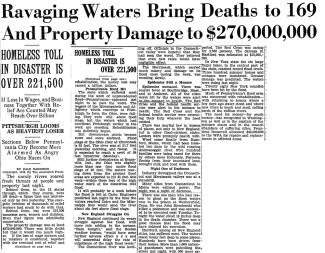Collection Name
About
Ravaging Waters Bring Deaths to 169 And Property Damage to $270,000,000
HOMELESS TOLL IN DISASTER IS OVER 221,500
If Loss In Wages, and Business Together With Relief Are Counted May Reach Over Billion
PITTSBURGH LOOMS AS HEAVIEST LOSER
Sections Below Pennsylvania City Become More Alarmed As Angry Ohio Races On
BY DALE HARBISON
The unruly rivers roared fresh threats at people and property last night.
Behind them, in the 13 states through which they course, were 169 dead—a figure that was increased only by two yesterday. The energetic heroism of thousands of relief workers had much to do with that.
Behind them, too, were 221,500 homeless men, women and children. Even that figure was admittedly conservative.
The property damage was at least $270,000,000. There was little doubt but that it would rise much higher. If the loss of wage earners and to retailers is considered, together with the eventual cost of relief and (Continued on page two.) rehabilitation, the money cost may exceed a billion dollars.
Pennsylvania Hard Hit
The state which suffered most during the week of unprecedented flood—-Pennsylvania—appeared last night to be past the worst. The wagers of the Monongahela and Allegheny which converge at Pittsburgh to form the Ohio, were falling. They were still above flood stage, but the waters which had overflown Pittsburgh earlier in the week are receding. Rehabilitation was definitely begun.
But downstream points became more and more alarmed. Flood stage of the Ohio river at Cincinnati is 52 feet. The river was at 51.7 feet yesterday morning, and rising. It is expected to reach a crest of 59 feet tomorrow (Monday). Still further downstream at Evansville, Ind., the Ohio was slightly more than one foot under flood stage of 35 feet. The waters roaring down from the present flood areas are expected to hit 45 feet this week—within three feet of the high water mark of the disastrous 1913 flood.
It will probably be a week before the flood is felt at Cairo. Engineers predicted last night by the time the waters reached Cairo and the Mississippi they would send the river about six feet above flood stage.
New England Struggles On
New England continued its weary struggle against the flood, with more rain adding to the menace. "Rain tonight," said the Boston weather bureau, "would have some further adverse effect x x x and will somewhat delay the rate of subsidence of the high flood levels."
The Connecticut river was levelling off. Officials in the Connecticut valley were hopeful that they had seen the worst. They believed that even new rains would have negligible effect.
The Merrimack, which carried much misery and damage on its flood crest during the week, was receding slowly.
Epidemics Still a Menace
Epidemics menaced. There was scarlet fever at Southbridge, Mass., and at Amherst. All of the cities worst hit by the waters were alert to the menace to health. The Red Cross and the federal health service were extending their help wherever the need existed.
There was martial law in dozens of places, not only in New England, but in other flood-stricken states. Looters were promptly dealt with.
Word came finally from Rumford, Maine, which had been isolated two days by the wild running Androscoggin river. Five hundred families were being cared for there by others more fortunate. Farmers, fleeing from their inundated land, brought milk and food with them.
Night One of Darkness
Industry throughout the Connecticut and Merrimack valleys was at a standstill.
Many cities from Connecticut to Maine were without power. The night was a night of darkness.
There was one man who had reason to gloat as the flood waters rose in the prison at Wethersfield, Conn. He was John Siemborski who killed a policeman and was sentenced to be executed next Tuesday. Tonight the water stood 18 inches deep in the death chamber. There was a good chance that the flood may have delayed his execution.
Hartford, among all New England cities, has suffered most. The waters stand many feet deep in some places. Hundreds have been driven from their homes. More than 1,000 national guardsmen were patrolling the street last night, with 500 more expected. The Red Cross was caring for 2,500 persons. The damage in Hartford was estimated at $10,000,000.
In New York state the six large finger lakes, in the central part of the state, reached record flood levels. Three hundred summer homes and cottages were inundated. Greater damage was predicted. The waters were rising last night.
Twenty eight New York counties have been hit by the flood.
Much of Pennsylvania's flood area was concerned with rehabilitation— with returning to homes where a few days ago water stood and where now there is muck and mud, calling cards of the ruffian rivers.
The need for money—for much money—was recognized in Washington as well as in the capitals of the stricken states and in the council chambers of suffering cities. President Roosevelt allocated $43,000,000 to the WPA for repairs and replacements in affected areas.
